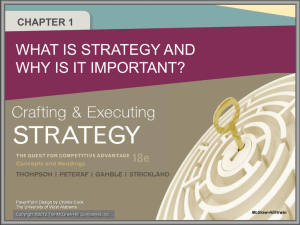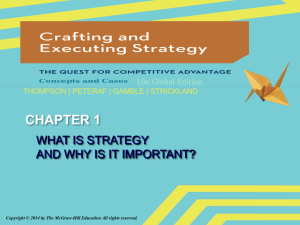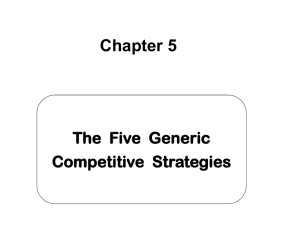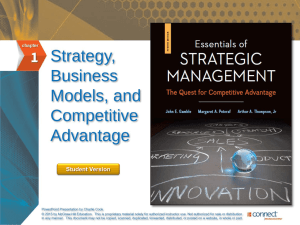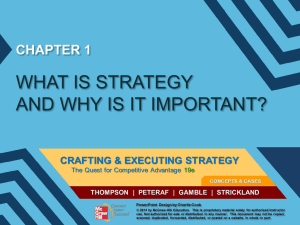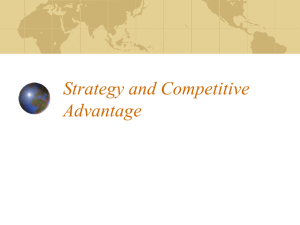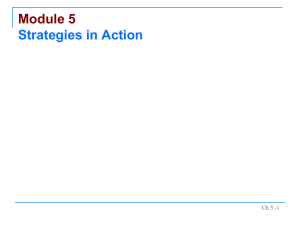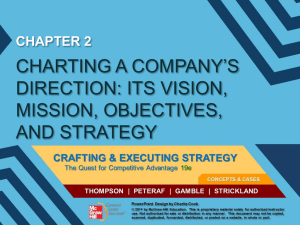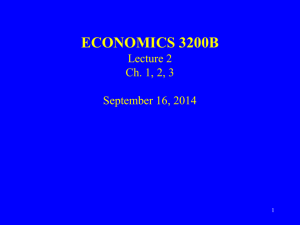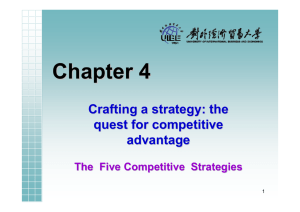Week 1
advertisement
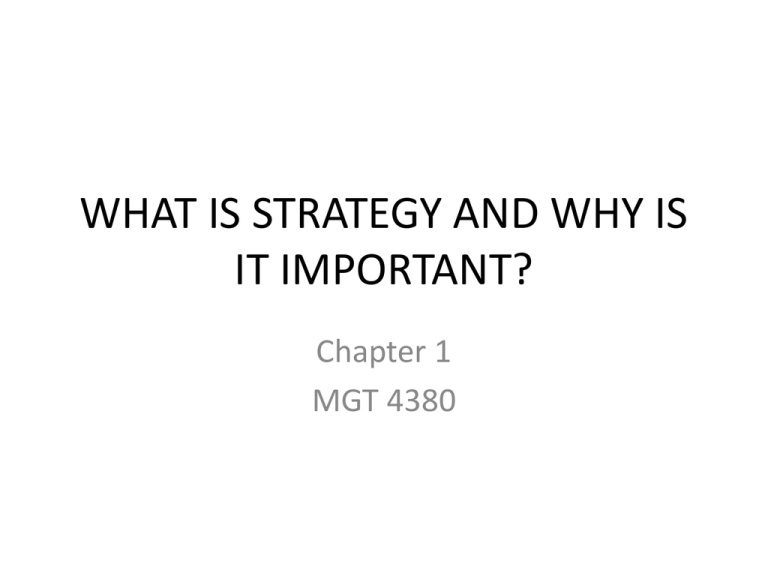
WHAT IS STRATEGY AND WHY IS IT IMPORTANT? Chapter 1 MGT 4380 Chapter 1 Outcomes LO1 Understand why every company needs a sound strategy to compete successfully, manage its business operations, and strengthen its prospects for long-term success. LO2 Develop an awareness of the five most dependable strategic approaches for setting a company apart from rivals and winning a sustainable competitive advantage. LO3 Understand that a company’s strategy tends to evolve over time because of changing circumstances and ongoing management efforts to improve the company’s strategy. LO4 Learn why it is important for a company to have a viable business model that outlines the company’s customer value proposition and its profit formula. LO5 Learn the three tests of a winning strategy. Strategy’s Three Central Questions • Where are we now? – Current financial performance – Market standing – Competitive resources and capabilities – Changing industry conditions • Where do we want to go from here? – What buyer needs to try to satisfy? – Which growth opportunities to emphasize? – How to change the business makeup? • How are we going to get there? – Which competitive moves and business approaches to use as a strategy? What Do We Mean By Strategy? • A firm’s strategy is all about how: – How to attract and please customers. – How to compete against rivals. – How to position the firm in the marketplace to capitalize on attractive growth opportunities. – How best to respond to changing economic and market conditions. – How to manage each functional piece of the business. – How to achieve the firm’s performance targets. What Do We Mean By Strategy? FIGURE 1.1 – Elements of a Company’s Strategy Core Concept A company’s strategy consists of the competitive moves and business approaches management has developed to attract and please customers, compete successfully, capitalize on opportunities to grow the business, respond to changing market conditions, conduct operations, and achieve performance objectives. Strategy and the Quest for Competitive Advantage • Gaining a sustainable competitive advantage requires: – Choosing to compete differently by doing what rivals don’t do or can’t do. – Appealing to buyers in ways that set the firm apart from its rivals. – Staking out a market position that is not crowded with strong rivals. McDonald’s Strategy in the QuickService Restaurant Industry • Key initiatives of the Plan-to-Win strategy included: • Improved restaurant operations • Affordable pricing • Wide menu variety and beverage choices • Convenience and expansion of dining opportunities • Ongoing restaurant reinvestment and international expansion Core Concept A firm achieves sustainable competitive advantage when an attractively large number of buyers develop a durable preference for its products or services over the offerings of competitors, despite the efforts of competitors to overcome or erode its advantage. • Mimicking the strategies of successful industry rivals—with either copycat product offerings or efforts to stake out the same market position—rarely works. • A creative, distinctive strategy that sets a firm apart from rivals and yields a competitive advantage is a firm’s most reliable ticket for earning above-average profits. Choosing a Strategic Approach Michael Porter (1980) outlined several major “generic strategies” to set a company apart from its competitors 1. A low-cost provider strategy (e.g., Wal-Mart, Southwest Airlines) 2. A broad differentiation strategy (e.g., Johnson & Johnson (reliability-quality), Apple (innovation)) 3. A focused low-cost strategy (e.g., Food Club, Bar-S Foods) 4. A focused differentiation strategy (e.g., Rolex, Ferrari, Patagonia) 5. A best-cost provider strategy (e.g., Target, BJ’s) Porter’s Generic Strategies Type of Strategy Scope of Offering Broad Low-Cost Differentiation Broad Broad Differentiation Low-Cost Best-Cost (Or Stuck in the Middle) Focused Focused Focused Low-Cost Differentiation Why Strategy Evolves Over Time • A strategy changes over time as: – – – – – Competitors make unexpected moves The needs and preferences of buyers change New market opportunities emerge Managers develop new ideas to improve the strategy Evidence mounts that the strategy is not working well • A strategy evolves: – Incrementally or dramatically – Proactively and adaptively Core Concept Changing circumstances and ongoing management efforts to improve the strategy cause a company’s strategy to evolve over time—a condition that makes the task of crafting a strategy a work in progress, not a onetime event. Deliberate, Emergent, Realized, & Abandoned Strategies FIGURE 1.2 – Planned v. Unplanned Strategies Core Concept A firm’s business model sets forth how its strategy and operating approaches will create value for customers, while at the same time generate ample revenues to cover costs and realize a profit. The two elements of a firm’s business model are (1) its customer value proposition and (2) its profit formula. Strategy and a Firm’s Business Model • Business Model – Management’s blueprint for delivering a product or service to customers that will generate revenues sufficient to cover costs and yield an attractive profit. • Business Model Elements – The firm’s customer value proposition for satisfying buyer wants and needs at a perceived good value. – The firm’s profit formula sets out how the firm’s cost structure will allow for acceptable profits given the pricing tied to its customer value proposition. Netflix & Redbox: Two Contrasting Business Models Netflix Redbox Value Proposition Convenient delivery of movies to customers’ mailboxes or streamed to their PCs, Macs, or TVs. Economical 24-hour movie rentals and purchases that could be picked up at conveniently located DVD kiosks. Profit Formula Revenue Generation: Monthly subscription fees from millions of subscribers Revenue Generation: Customers could rent DVDs and purchase DVDs from Redbox’s DVD vending machine kiosks. Cost structure: Fixed and variable costs associated with DVD acquisitions, licensing fees and revenue sharing agreements, development of movie selection software, website operation and maintenance, Internet streaming capabilities, distribution center operations, and administrative activities. Profit Margin: Netflix’s profitability was dependent on attracting a sufficiently large number of subscribers to cover its costs and provide for attractive profits. Cost Structure: Fixed and variable costs associated with the kiosk purchases and deployment, DVD acquisitions, licensing fees and revenue sharing agreements, website operation and maintenance, kiosk stocking, and administrative activities. Profit Margin: Redbox’s profitability was dependent on generating sufficient revenues from DVD rentals and sales to cover costs and provide for a healthy bottom line. Three Tests of a Winning Strategy Fit How well does the strategy fit the firm’s situation? Competitive Advantage Is the firm achieving sustainable competitive advantage? Performance Is the strategy producing good company performance? A winning strategy must fit the firm’s external and internal situation, build sustainable competitive advantage, and improve company performance. Measuring the Caliber of a Firm’s Strategy • Is the strategy producing good performance? – Is the firm gaining in profitability and financial strength? – Is the firm gaining in competitive strength and market standing? • Assessing current and proposed strategies: – Do they have good fit? – Do they offer a sustainable competitive advantage? – Are they capable of contributing to above-average performance or performance improvements?
